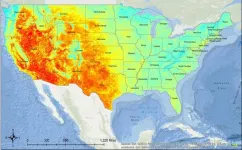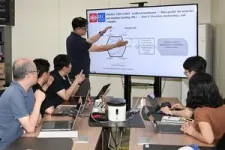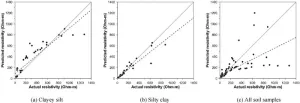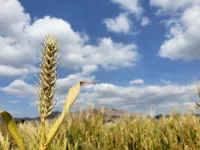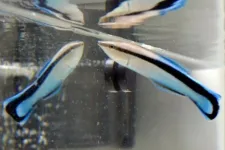(Press-News.org) A neighborhood’s walkability is affected by many factors such as street connectivity and density; access to destinations and aesthetics; investment in walking and biking infrastructure; and the presence or absence of urban natural features, specifically tree cover.
Not all neighborhoods are alike. Many neighborhoods in impoverished and minority communities lack the cooling effect of vegetation and tree cover, especially in urbanized areas. As a result, residents face the “heat island effect,” where temperatures remain higher in urban areas compared to the surrounding rural or natural environments.
Past discriminatory housing policies, like redlining, have played a significant role in disproportionately exposing low-income urban communities to extreme heat. Redlining, a practice that began in the United States during the 1930s, involved marking minority, low-income and migrant neighborhoods as “hazardous” with a red color on maps used by the Home Owners' Loan Corporation for mortgage and insurance decisions.
One possible consequence of historic redlining policies is their enduring effect on the built environment, which includes less greenspace and tree cover, coupled with increased pavement, which in turn raises the likelihood of experiencing urban heat island effects.
To date, no known studies have examined the relationships between urban heat islands, historic redlining, and neighborhood walking in older adults.
To fill this gap, a study led by Florida Atlantic University in collaboration with the University of Miami, examined how individual and neighborhood characteristics, including historic redlining scores, vary with how hot the ground gets in the summer (maximum summer land surface temperature). Researchers also investigated whether higher summer land surface temperature is linked to reduced walking in older adults, and if this relationship varies based on historic redlining scores; and whether neighborhoods with higher redlining scores experience higher summer land surface temperatures.
The study, published in the Journal of Urban Health, suggests that discriminatory policies such as historic redlining have left indelible marks on neighborhoods across the U.S., leaving communities more vulnerable to detrimental environmental exposures, including extreme heat.
Results show that higher summer temperatures were linked to reduced neighborhood walking time, though this was significant only for neighborhoods rated as “still desirable” and “best.” In neighborhoods rated as “definitely declining” or “hazardous,” there was no significant link between temperature and walking, which could be due to a lack of alternative recreational activities, or the fact that lower-income residents walk more for essential tasks and cost-saving reasons. Additionally, neighborhoods with poorer redlining scores had higher peak summer temperatures.
“Neighborhoods with historic redlining scores of ‘still desirable’ and ‘best’ tend to have more favorable built and social environments for walking, such as higher socioeconomic status, more greenspace, and better pedestrian amenities,” said Diana Mitsova, Ph.D., senior author and chair and professor of the Department of Urban and Regional Planning within FAU’s Charles E. Schmidt College of Science. “However, we found that people in these affluent neighborhoods walked less when temperatures were higher. This might be because older adults in wealthier areas often have alternative transportation options and other ways to exercise, so they may reduce walking in extreme heat.”
Findings also show:
People living in the South and West had lower peak summer temperatures compared to those in the Northeast and Midwest
Neighborhoods with higher area deprivation and more African American/Black residents experienced higher summer temperatures
Neighborhoods rated as “best” for redlining had lower peak summer temperatures than those with other redlining scores
Hispanic and Asian individuals, as well as those with higher incomes, were less likely to live in areas with high summer temperatures
“While more research is required, our findings highlight the urgent need to address urban heat islands in historically marginalized communities,” said Mitsova. “This is especially critical as older adults in these areas, who are more vulnerable to heat-related health issues, face greater exposure to extreme temperatures and associated health risks.”
For the study, researchers used data from the 2017 National Household Travel Survey, which included information from more than 260,000 people. They combined this with summer temperature data and linked it to social and environmental characteristics, including historic redlining scores. They also assessed the amount of greenspace in each respondent’s neighborhood. The study focused on 3,982 older adults with an average age of 73 years.
Study co-authors are Lilah M. Besser, Ph.D., and Elaine T. Le, Department of Neurology, Comprehensive Center for Brain Health, University of Miami Miller School of Medicine.
- FAU -
About Florida Atlantic University:
Florida Atlantic University, established in 1961, officially opened its doors in 1964 as the fifth public university in Florida. Today, the University serves more than 30,000 undergraduate and graduate students across six campuses located along the southeast Florida coast. In recent years, the University has doubled its research expenditures and outpaced its peers in student achievement rates. Through the coexistence of access and excellence, FAU embodies an innovative model where traditional achievement gaps vanish. FAU is designated a Hispanic-serving institution, ranked as a top public university by U.S. News & World Report and a High Research Activity institution by the Carnegie Foundation for the Advancement of Teaching. For more information, visit www.fau.edu.
END
Recently, many major countries around the world, starting with the U.S., Japan, Germany, China, U.K., etc., have issued an administrative order to ensure the safety of AI technology, putting an emphasis on the safe, effective implementation of AI into their systems. In line with such trends, Korean researchers have collaborated with renowned AI experts from all around the world to create new AI-related international standards, garnering attention from the global AI community.
Proposal No.
Title
Status
ISO/IEC ...
WHAT:
Newborns who had an atypical pattern of metabolites were more than 14 times as likely to die of sudden infant death syndrome (SIDS), compared to infants who had more typical metabolic patterns, according to a study funded in part by the National Institutes of Health. Metabolites are molecules produced by the body’s various chemical reactions. Researchers found that infants who died of SIDS had a specific pattern of metabolites compared to infants who lived to their first year. The researchers believe that checking for this pattern could provide ...
Biotechnological pesticides are a promising alternative to traditional chemical pesticides. But we have limited knowledge of how toxic they are to other organisms in the environment beyond regulatory assessments. A new research centre will now work to provide this knowledge – especially to ensure the EU has a chance of joining the growing market for biotechnological pesticides. As for now, Europe has failed to keep up.
"If a thing kills something, we need to know how it kills, and who and what else it may kill," says Professor Nina Cedergreen of the University of Copenhagen’s Department of Plant and Environmental Sciences.
She is ...
Proper power grounding systems are necessary for maintaining the safety and reliability of critical electrical subsystem infrastructure, such as substations. Power grounding systems provide a low-resistance path for electrical fault currents to flow into the earth, preventing electrical shocks, fires, and damage to vital equipment. Investigation of soil resistivity is crucial for designing power grounding systems. For the most cost-effective and efficient grounding systems for electrical substations, it is imperative to carefully ...
Researchers at Chalmers University of Technology, in Sweden, have for the first time succeeded in combining two major research fields in photonics by creating a nanoobject with unique optical qualities. Since the object is a thousand times thinner than the human hair, yet very powerful, the breakthrough has great potential in the development of efficient and compact nonlinear optical devices. “My feeling is that this discovery has a great potential,” says Professor Timur Shegai, who led the study at Chalmers.
Photonic applications harness the power of light-matter interactions to generate ...
Thanks to an experiment started before the Great Depression, researchers have pinpointed the genes behind the remarkable adaptability of barley, a key ingredient in beer and whiskey. These insights could ensure the crop’s continued survival amidst rapid climate change.
Grown everywhere from Asia and Egypt to Norway and the Andes mountains of South America, barley is one of the world’s most important cereal crops and has been for at least 12,000 years. As it has spread across the globe, random ...
PULLMAN, Wash. -- A computer algorithm can efficiently find genetic mutations that work together to drive cancer as well as other important genetic clues that researchers might someday use to develop new treatments for a variety of cancers.
Reporting in the journal Frontiers in Bioinformatics, a Washington State University-led team used a novel network computer model to find co-occurring mutations as well as other similarities among DNA sequence elements across several types of cancer. The model allows for easier searches for patterns in huge seas of cancer genetic data.
“This is a ...
What if that proverbial man in the mirror was a fish? Would it change its ways? According to an Osaka Metropolitan University-led research group, yes, it would.
In what the researchers say in Scientific Reports is the first time for a non-human animal to be demonstrated to possess some mental states (e.g., mental body image, standards, intentions, goals), which are elements of private self-awareness, bluestreak cleaner wrasse (Labroides dimidiatus) checked their body size in a mirror before choosing whether to attack fish that were slightly larger or smaller than themselves.
The ...
LA JOLLA, CA—It’s a dogma taught in every introductory biology class: Proteins are composed of combinations of 20 different amino acids, arranged into diverse sequences like words. But researchers trying to engineer biologic molecules with new functions have long felt limited by those 20 basic building blocks and strived to develop ways of putting new building blocks—called non-canonical amino acids—into their proteins.
Now, scientists at Scripps Research have designed a new paradigm for easily adding non-canonical amino acids to proteins. Their approach, described in Nature Biotechnology on September 11, 2024, revolves around using ...
A groundbreaking study led by researchers at the University of Colorado Anschutz Medical Campus reveals that stress-induced changes in sperm motility occur after a stressful event, rather than during it and improves sperm performance. The discovery is essential in understanding how stress impacts the reproductive process to improve fetal development outcomes.
The study was published today in Nature Communications.
Over the last five decades, there has been a notable decline in semen quality, which has coincided with environmental stressors. This new research identifies how stress affects the ability of ...
